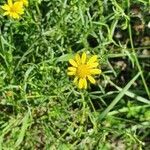Perennial herb, up to 1 m high; branching from base, woody, glabrous or sparsely hairy, leafy, often with axillary leaf tufts. Leaves: blade linear to very narrowly elliptic, up to 100 x 10 mm, apex acute, base half-clasping, often hastately eared, lower leaves sometimes narrowed to petiole-like base, margins ± revolute, denticulate, sometimes coarsely dentate or pinnately lobed; glabrous, stems uniformly leafy. Heads radiate, few to many on long, bracteate peduncles arranged in open, corymbose panicles. Involucral bracts 20, (4-)5(-7) mm long, slightly shorter than or equalling disc florets; calyculus bracts few, often dark tipped, not overlapping, much shorter than involucre. Flowers: ray florets 7-13; ray and disc florets canary-yellow; Jul.-Jun. Fruit with cypsela (and ovary?) cylindric, hispid between ribs. (including S. laevigatus Thunb. var. integrifolius Harv.) Often misidentified as S. burchellii DC., but that species only occurs in WC.
Bushy, perennial herb, up to 1 m high, ± glabrous. Stems branching from a woody base, leafy, often with axillary leaf tufts. Leaves up to 100 x 10 mm, mostly linear to narrowly lanceolate, rarely lobed, apex acute, base half-clasping, often hastately eared, margins ± revolute, mostly denticulate. Inflorescence an open panicle; peduncles long. Capitula few-many, radiate, disc and rays (7-13) canary yellow, rays often rolled under; involucre campanulate; bracts ± 20, 4-7 mm long, resinous; calyculus bracts few, often dark-tipped. Flowering time all year, mainly Oct.-Feb. Cypselae cylindrical, 2.0-2.5 mm long, hispid between ribs.
Perennial herb, up to 1 m high. Leaves glabrous, stems uniformly leafy. Heads radiate, rays 13; involucral bracts 20, (4-)5(-7) mm long, calyculus bracts few, not overlapping, much shorter than involucre. Achenes hispid between ribs. Flowers canary-yellow.
A herb. It grows 1 m high. The leaves are very narrow and 4 mm wide. The flowers are in a loose group.












